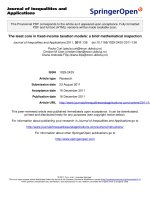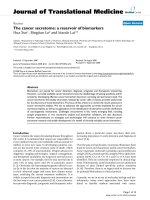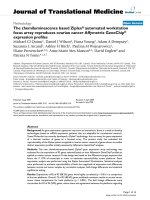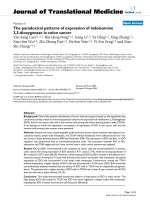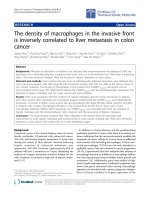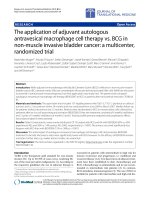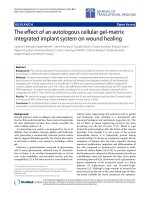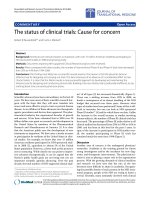báo cáo hóa học: " The sensory feedback mechanisms enabling couples to walk synchronously: An initial investigation" ppt
Bạn đang xem bản rút gọn của tài liệu. Xem và tải ngay bản đầy đủ của tài liệu tại đây (283.38 KB, 5 trang )
BioMed Central
Page 1 of 5
(page number not for citation purposes)
Journal of NeuroEngineering and
Rehabilitation
Open Access
Short report
The sensory feedback mechanisms enabling couples to walk
synchronously: An initial investigation
Ari Z Zivotofsky
1
and Jeffrey M Hausdorff*
2,3,4
Address:
1
Gonda Brain Research Center, Bar Ilan University, Ramat Gan, Israel,
2
Laboratory for Gait & Neurodynamics, Movement Disorders Unit,
Tel-Aviv Sourasky Medical Center, Tel-Aviv, Israel,
3
Department of Medicine, Harvard Medical School, Boston, MA, USA and
4
Physical Therapy
Department; Sackler School of Medicine, Tel Aviv, Israel
Email: Ari Z Zivotofsky - ; Jeffrey M Hausdorff* -
* Corresponding author
Abstract
The inattentive eye often will not notice it, but synchronization among human walking partners is
quite common. In this first investigation of this phenomenon, we studied its frequency and the
mechanisms that contribute to this form of "entrainment." Specifically, by modifying the available
communication links between two walking partners, we isolated the feedback mechanisms that
enable couples to synchronize their stepping pattern when they walk side-by-side. Although
subjects were unaware of the research aims and were not specifically asked to walk in synchrony,
we observed synchronized walking in almost 50% of the walking trials, among couples who do not
usually walk together. The strongest in-phase synchrony occurred in the presence of tactile
feedback (i.e., handholding), perhaps because of lower and upper extremity coupling driven in part
by arm swing. Interestingly, however, even in the absence of visual or auditory communication,
couples also frequently walked in synchrony while 180 degrees out-of-phase, likely using different
feedback mechanisms. These findings may partially explain how patients with certain gait disorders
and disturbed rhythm enhance their gait when they walk with a partner and suggest alternative
interventions that might improve the stepping pattern. Further, this preliminary investigation
highlights the relatively ubiquitous nature of an interesting phenomenon that has not previously
been studied and suggests that further work is needed to better understand the mechanisms that
entrain the gait of two walking partners and allows couples to walk in synchrony with minimal or
no conscious effort.
Background
When two people walk together, they often appear to step
in almost perfect synchrony (e.g., see Fig. 1a and 1b). Step
length and step time can be varied in numerous ways to
ensure that walking partners move forward at the same
rate and arrive at the desired destination together. How-
ever, instead of achieving this goal through a random,
time-varying combination of these parameters, remarka-
bly, couples often seem to march to a single drummer.
What sensory mechanisms are employed to synchronize
their walking patterns?
This phenomenon of independent organisms working in
synchrony is not unique to people walking together. A
wide variety of physical and physiological phenomena
synchronize their actions [1]. This entrainment of inde-
pendent entities generally requires a form of communica-
tion. Isolated heart cells beat synchronously in a properly
Published: 8 August 2007
Journal of NeuroEngineering and Rehabilitation 2007, 4:28 doi:10.1186/1743-0003-4-28
Received: 22 November 2006
Accepted: 8 August 2007
This article is available from: />© 2007 Zivotofsky and Hausdorff; licensee BioMed Central Ltd.
This is an Open Access article distributed under the terms of the Creative Commons Attribution License ( />),
which permits unrestricted use, distribution, and reproduction in any medium, provided the original work is properly cited.
Journal of NeuroEngineering and Rehabilitation 2007, 4:28 />Page 2 of 5
(page number not for citation purposes)
adjusted cell culture, and individuals in an audience clap
in unison using auditory feedback. More subtle forms of
communication synchronize the menstrual cycle of
women who live together in close proximity [2] and ena-
ble locusts to couple the beating of their wings [3]. For
example, the rhythmically oscillating airflow from the
front locust's wing-beat transmits the timing information
needed for synchronization to the rear individual [3].
While these examples are not gait related, they represent
instances where separate individuals synchronize a bio-
logical facet via a specific feedback mechanism. It is this
sort of synchrony and feedback that we are investigating
in this study. Certain patients with severe gait distur-
bances may improve their stepping pattern when they
walk with a partner [4], and anecdotally, we have
observed that these patients often entrain their walking
pattern to that of their partner's, using synchronization to
generate near-normal walking. However, the mechanisms
that enable this entrainment of the walking pattern are
largely unknown.
The gait of healthy adults is generally considered to be an
automated motor task. In fact, walking is actually a highly
complex, hierarchical process that is regulated by multiple
internal brain networks and feedback mechanisms.
Patients with disturbances in these mechanisms (e.g., Par-
kinson's disease) may use external sources such as peri-
odic visual or auditory stimuli to synchronize their gait
and thereby improve their walking rhythm [5,6]. What
sort of communication is utilized when a couple walks
together in synchrony? Visual, auditory, and tactile feed-
back are likely candidates. We tested this idea by isolating
each of these factors and quantifying the degree of syn-
chrony as couples walked side-by-side. Although this phe-
nomenon may be observed in everyday experience, to our
knowledge, this is the first attempt to examine its fre-
quency and study the sensory feedback and coupling
mechanisms that contribute to synchronized walking
when couples walk side-by-side. Specifically, we tested the
hypothesis that visual, auditory, and tactile communica-
tion between walking partners enables couples to walk in
synchrony.
Methods
Twenty-eight (14 pairs) middle school (13.8 ± 1.1 yrs),
healthy young women were studied. Parental approval
was provided and all provided informed consent prior to
the study and all were blinded to the objectives of the
study. Each pair walked under four different conditions
that modified the available feedback. In each condition,
participants were told to walk from one end of a 15-meter
long hallway to the other end when they received the
"start" signal. No instructions were given regarding "syn-
chrony" and this idea was never explicitly mentioned to
the participants. Please note that their starting simultane-
ously does not necessarily dictate synchrony: Their very
first steps could have been of different stride lengths or
step rates. Feedback, specifically with respect to the walk-
ing partner, was modified using side-blinders to decrease
the visual field and prevent subjects from seeing their part-
ner (no Visual Feedback condition), using headphones
though which white noise was played to prevent subjects
from hearing their partner's steps (no Auditory Feedback
condition) and/or by having subjects walk while holding
hands (Tactile Feedback condition). Thus, the four feed-
back conditions were:
1. Auditory feedback was unaltered. No visual or tactile
feedback.
2. Visual feedback was unaltered. No auditory or tactile
feedback.
3. Tactile feedback provided via handholding. No audi-
tory or visual feedback.
4. No feedback (i.e., no auditory, visual or tactile feed-
back).
During each trial, subjects walked side-by-side on level
ground in a quiet, obstacle free, well-lit hallway. They
were asked to walk from one end of the hallway to the
other end (about 15 m) at their normal pace. The lower
extremities of the subjects were videotaped and two
experts in gait analysis (physical therapists) reviewed the
videos offline. The reviewers were told to focus on the
Example of two couples walking in synchronyFigure 1
Example of two couples walking in synchrony. (A) Two older
adults walking in the street and (B) the Wright brothers at
the Belmont International Airmeet. The walking partners do
not appear to be looking at each other and there is no appar-
ent contact, yet the partners apparently walk as one. In the
present study, we investigate the factors that enable synchro-
nized walking such as that seen in these two examples.
Journal of NeuroEngineering and Rehabilitation 2007, 4:28 />Page 3 of 5
(page number not for citation purposes)
middle 1/3 of each walk in order to study the steady-state
behavior. Reviewers assigned to each trial a score from -3
to 3; 0 reflects total absence of synchronization, 3 reflects
good (e.g., consistent) in-phase synchronization (e.g., left
leg of one partner moved in time with the left leg of the
other partner), and -3 reflects good (e.g., consistent) 180
degrees out-of-phase synchronization (e.g., left leg of one
partner moved with the right leg of the other partner).
Scores of 1.0 and 2.0 reflect mild and moderate in-phase
synchronization, respectively. Each review was performed
without knowledge of the results of the other and without
knowledge of the specific study questions. There was good
agreement between the two reviewers (Intraclass Correla-
tion Coefficient, ICC, alpha = 0.87). Scores were averaged
across the reviewers. To determine if the frequency of syn-
chronization was different from chance, binomial tests
were performed to test the hypothesis that the proportion
of couples demonstrating synchronization (a binary vari-
able that was positive if the average absolute scores were
greater than 1.0) in any given feedback condition was sta-
tistically different from 0.1 (i.e., 10%). To test whether the
degree of synchronization was different from the no feed-
back condition, paired t-tests were performed comparing
this condition to the others.
Results
Synchronized walking (absolute value of synchrony
score> 1.0) occurred frequently (26 out of 56 trials, 46%).
Among all conditions, in-phase synchrony (score> 1.0)
occurred most frequently (50% of trials in this condition)
with tactile feedback (see Fig. 2a and Fig. 3). The syn-
chrony score in the no feedback condition (see, for exam-
ple, Fig. 2b) was significantly lower than that of the tactile
condition (p < 0.05), but was not different from the audi-
tory or visual feedback conditions (p > 0.32). Handhold-
ing apparently promotes in-phase synchrony, but visual
and auditory feedback apparently do not.
A different, more puzzling picture is observed for out-of-
phase synchrony. Among the 56 walking trials, the fre-
quency of this type of synchrony was similar to that of in-
phase synchrony (14/56 vs. 12/56, respectively). For this
type of coupled walking, the frequency of good synchrony
and the synchronization scores were similar in the audi-
tory, tactile and no feedback conditions (29%, 29%, and
36%, respectively). In contrast, walking with intact visual
feedback had a negative effect on synchrony, reducing the
observed frequency (to 7%, i.e., only 1 couple) and low-
ering the magnitude (p = 0.014, compared to the no feed-
back condition). Differences in height among the walking
partners did not explain when out-of-phase synchrony
occurred instead of in-phase walking, and were not asso-
ciated with the presence or absence of any kind of syn-
chrony (p > 0.15).
Discussion
In this first study of synchronized walking, we found that
its frequency is relatively high. Although the couples were
never asked to walk synchronously and this was the first
time they walked together as couples, they did in fact walk
as a synchronized unit in almost 50% of all the trials. This
is far above what might be expected by chance; there are
an infinite number of combinations of stride length and
step rates that can produce a given walking speed, and left
to chance, two walkers should essentially never synchro-
nize. The interesting finding is those conditions in which
there is any synchrony, not those with low probabilities of
synchrony. These results confirm our anecdotal observa-
Frequency of in-phase synchronized walking (synchrony score>1Figure 3
Frequency of in-phase synchronized walking (synchrony
score>1.0) as a function of the specific type of feedback. In
the tactile feedback condition (handholding without visual or
auditory feedback), 50% of the couples walked in synchrony
in-phase. * Indicates significant difference from chance, (i.e., >
10% in good synchrony, p < 0.001).
(A) Snapshots taken during a tactile feedback (handholding) trial that received a score of 3Figure 2
(A) Snapshots taken during a tactile feedback (handholding)
trial that received a score of 3.0 (good in-phase synchrony).
Note how the heel-strike and toe-off of both walking part-
ners occur simultaneously. (B) Snapshots of the same couple
shown in (A) during a no feedback trial that received a score
of -0.5 (poor synchrony). A suggestion of out-of-phase syn-
chrony can be observed in the left and right panels, but this is
not consistent (see middle panel).
Journal of NeuroEngineering and Rehabilitation 2007, 4:28 />Page 4 of 5
(page number not for citation purposes)
tions; having become sensitive to the possibility that cou-
ples may walk in synchrony, we observe that two walking
partners are often unconsciously walking in synchrony. A
natural question addressed here is what contributes to the
ubiquity of this phenomenon. This preliminary investiga-
tion revealed that in the presence of tactile feedback, in-
phase synchrony is likely while neither visual nor auditory
feedback increase the likelihood of in-phase synchrony
above that seen with no feedback. It may be that vision
acts as a distraction, thus interfering with the ability of the
walkers to synchronize.
The mechanisms for the first part of these results may be
explainable on the basis of previous investigations that
demonstrated that the light touch of a single finger mark-
edly improves balance and reduces postural sway [7-9].
Here we demonstrate the importance of light touch on
step timing. Synchronized walked occurred when couples
held hands, while visual and auditory feedback between
the walking partners was blocked. One possibility is that
the light touch of handholding provides a "communica-
tion link" that synchronizes the two walking partners.
Alternatively, one could argue that this finding is antici-
pated. Hand-holding also imposes a biomechanical con-
straint, to some degree, and within individuals, arm swing
and step timing may be interconnected [10,11]. Thus, per-
haps the stepping pattern of one subject determines the
movement of the arm in that subject, which in turn, sets
the arm movement pattern and then the step timing of the
walking partner. In other words, perhaps, lower limb/
upper limb coupling of one individual dictates arm swing
timing, which in turn determines the arm swing timing,
and hence, lower limb pattern of the partner. Nonethe-
less, despite this constraint, it is important to note that
step length and step time can be combined in many ways,
even in the presence of hand-holding, without necessarily
imposing synchrony. Indeed, in the present study, half of
the couples walked in synchrony in this condition while
half did not. It remains to be determined if hand-holding
predisposes to synchronized walking by providing tactile
feedback, perhaps similar to light-touch, or if the biome-
chanical constraint is the key factor. Clearly, however,
handholding alone is not strong enough to evoke uncon-
scious synchronized walking one hundred percent of the
time. Understanding the role of tactile feedback in healthy
subjects may suggest how touch and hand holding helps
patients with certain types of gait disturbances because
they appear to utilize similar mechanisms when they walk
with a partner.
The present findings suggest that synchronized walking
often occurs even if in the absence of tactile feedback or
biomechanical constraints. In fact, synchronized walking
(in and out of phase) was observed in many trials in
which subjects did not hold hands. Biomechanical con-
straints cannot explain the occurrence of synchronized
walking in these cases. An alternative, perhaps compli-
mentary, explanation for the observed results relates to a
recent investigation [12] of six pairs of subjects who
walked towards or away from one another, with one sub-
ject tending to "follow" or imitate the gait pattern of the
other. The authors suggest that bidirectional interactions
with mutual influences of each subject on one another are
responsible for this behavior. While vision tended to have
a negative effect in the present study, minimizing the
importance of "imitation", perhaps similar bidirectional
mechanisms may be influencing the gait of subjects who
walk side-by-side.
In the future, it might be helpful to compare side-by-side
walking with walking as subjects approach or move away
from each other, and to quantify the kinematics and
kinetics of the walking partners using video markers,
EMG, and/or footswitches, methods that are more quan-
titative than the method used in the present study. The
qualitative assessment used was a limitation of the present
study. In addition, to better understand the role of atten-
tion and the cognitive function required to walk in syn-
chrony, it might also be informative to examine the effects
of dual tasking on side-by-side synchrony. Further, in the
present study, subjects were assessed during the steady
state portion of a 15 meter walk. It might be helpful to
evaluate "start-up" effects as subjects reach a steady state
and to study synchronization during a longer walk.
This initial investigation suggests that synchronized walk-
ing is relatively commonplace and that it is apparently an
example of a more general phenomenon in which com-
plex biological rhythms become synchronized via readily
apparent as well as more inconspicuous mechanisms.
Identification of all of the sources of this synchronization
may be used to better understand the mechanisms behind
a perplexing everyday phenomenon and perhaps, ulti-
mately, to enhance the walking pattern of patients with
disturbed gait rhythm.
Competing interests
The author(s) declare that they have no competing inter-
ests.
Authors' contributions
AZZ designed the study, supervised data collection, and
drafted the manuscript. JMH participated in the design of
the study, helped with statistical analyses, and edited the
manuscript. Both authors read and approved the final
manuscript.
Acknowledgements
We thank L Gruendlinger, T Herman, MScPt, G Yogev, MScPt and E Muel-
ler, and the staff and students at Amit Noga High School of Beit Shemesh
for invaluable assistance.
Publish with BioMed Central and every
scientist can read your work free of charge
"BioMed Central will be the most significant development for
disseminating the results of biomedical research in our lifetime."
Sir Paul Nurse, Cancer Research UK
Your research papers will be:
available free of charge to the entire biomedical community
peer reviewed and published immediately upon acceptance
cited in PubMed and archived on PubMed Central
yours — you keep the copyright
Submit your manuscript here:
/>BioMedcentral
Journal of NeuroEngineering and Rehabilitation 2007, 4:28 />Page 5 of 5
(page number not for citation purposes)
References
1. Glass L: Synchronization and rhythmic processes in physiol-
ogy. Nature 2001, 410:277-284.
2. Stern K, McClintock MK: Regulation of ovulation by human phe-
romones. Nature 1998, 392:177-179.
3. Camhi J, Sumbre G, Wendler G: Wing-beat coupling between
flying locust pairs: preferred phase and lift enhancement. J
Exp Biol 1995, 198:1051-1063.
4. Hadar-Frumer M, Giladi N, Hausdorff JM: Idiopathic "cautious"
gait disorder of the elderly: Effects of reducing fear of failing.
Movement Disorders 2004, 19:S327-S327.
5. Morris ME, Iansek R, Matyas TA, Summers JJ: Stride length regula-
tion in Parkinson's disease. Normalization strategies and
underlying mechanisms. Brain 1996, 119 ( Pt 2):551-568.
6. Rubenstein TC, Giladi N, Hausdorff JM: The power of cueing to
circumvent dopamine deficits: A review of physical therapy
treatment of gait disturbances in Parkinson's disease. Mov
Disord 2002, 17:1148-1160.
7. Dickstein R, Shupert CL, Horak FB: Fingertip touch improves
postural stability in patients with peripheral neuropathy. Gait
Posture 2001, 14:238-247.
8. Dickstein R, Peterka RJ, Horak FB: Effects of light fingertip touch
on postural responses in subjects with diabetic neuropathy.
J Neurol Neurosurg Psychiatry 2003, 74:620-626.
9. Lackner JR, Rabin E, DiZio P: Stabilization of posture by preci-
sion touch of the index finger with rigid and flexible fila-
ments. Exp Brain Res 2001, 139:454-464.
10. Kubo M, Wagenaar RC, Saltzman E, Holt KG: Biomechanical
mechanism for transitions in phase and frequency of arm
and leg swing during walking. Biol Cybern 2004, 91:91-98.
11. Wagenaar RC, van Emmerik RE: Resonant frequencies of arms
and legs identify different walking patterns. J Biomech 2000,
33:853-861.
12. Ducourant T, Vieilledent S, Kerlirzin Y, Berthoz A: Timing and dis-
tance characteristics of interpersonal coordination during
locomotion. Neurosci Lett 2005, 389:6-11.
